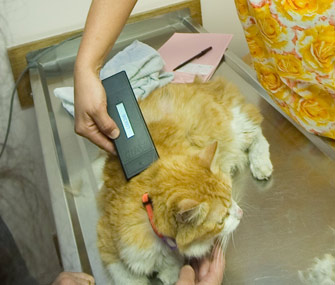Why Microchipping Cats Works
Published on April 19, 2012

License tags have long been the standard means for identifying dogs. Cats, however, have never been big tag wearers. Outdoor cats tend to catch their collars (and tags) on tree branches and other things, so many collars are purposefully made to break away. That makes tags almost useless, as well as expensive to replace. Indoor cats tend to remain collarless because their owners assume they won't get out the door. That assumption is too often wrong, however.
A few owners at one time tattooed their cats with an identification number, as was done with dogs, but the process was stressful and not always successful in the awake cat. Even when it worked, the tattoo often blurred with age, and it was frequently as difficult to read the tattoo as it was to place it!
Now microchips have added a better option. Microchips are tiny radio-frequency identification (RFID) chips, about the size of a grain of rice. Your veterinarian implants the chip using what looks much like a big hypodermic needle. The chip is placed under the cat's skin on the back between the shoulder blades. Most cats do not even react during the process, which is much like getting a vaccination.
How Microchips Work
You must register the chip number with the company that makes the chip, so that if your cat is found, it can be traced back to you. The chip must be read using a special scanner, which most veterinarians and shelters own. At one time, scanners were chip-specific, with chips from different manufacturers requiring separate scanners, but now universal scanners can read all modern chip types. The scanner is passed over the cat's back and sides, and the chip, if present, will transmit the chip's identification number to the scanner. The rescuer then contacts the national database, which in turn contacts the cat's owner. It is believed that more than 600,000 pets have been reunited with their owners as a result of microchips. Not only are chips valuable for returning lost pets but for proving ownership.
Some owners are concerned that the chip will cause an allergic reaction in their cat, or it will migrate to some other part of the cat. Chips have been in use for many years, and have been implanted in millions of pets, proving to be very safe. Chips are made of inert biocompatible materials, so that they do not cause allergic reactions. In the early years, some chips did migrate under the skin, but new technology has made migration rare.
What to Do If Your Cat Goes Missing
If you lose a cat that is microchipped, contact the chip manufacturer company or registration center with the pet's ID number. If you don't have the ID number on hand (and you should), the veterinarian who implanted the chip should have it. If you find a dog or cat, take it to a shelter or veterinarian to be scanned. If it has a chip, the owner can be found.
Microchips have one big disadvantage: They cannot be seen. They do come with a collar tag advising that the cat is chipped, but most cats don't wear collars. The best safety measure is still to keep your cat indoors and lock him in a separate room when you have company or workmen coming in and out. But even so, accidents happen and cats get out. Pets have been reunited with their owners years after being lost, thanks to their microchip. With luck, you'll never have to use your cat's chip number. But it's nice knowing it's there if you need it.





